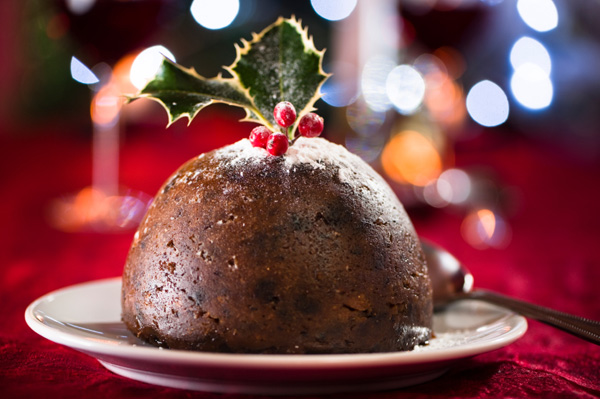Christmas food in six continents
Last week we looked at some special Christmas traditions from all over the globe. Today, we will examine in more detail one thing that most people would agree is an important part of Christmas traditions – food. So, relax, sit back, put your feet up by the open fire, and consider these interesting Christmas dishes that you probably never knew existed.

Christmas Pudding (UK)
Asia
As we saw last week, the Japanese like to eat fried chicken at Christmas. Apparently this tradition began due to an advertising campaign from the manager of the first KFC restaurant in Japan in the 1970s, under the title ‘Kentucky For Christmas!’. The campaign was so successful that forty years later people are queuing out the doors to buy their KFC on Christmas Day.
In India, only 3% of the population are Christian; but that still makes 30 million people! Many of these people live in the old Portuguese colony of Goa, and they will commonly eat coconut rice with chicken or mutton curry. A range of desserts are made around the Christmas period; some are similar to the British Christmas cake, and others are local to the region, including toffees, spiced cakes, rose-flavoured cookies and rice pudding.
In the Philippines, there are around 85 million Christians (out of 100 million people). Due to their Spanish colonial history, the most important meal time is Christmas Eve, or Nochebuena, and a traditional food is Morcon; beef stuffed with eggs, cheese and pickled vegetables. For dessert, it is common to eat the funnily named ‘Puto Bumbong‘, a sweet, sticky, purple, rice cake.
Africa
Just like in Japan, fried chicken is also popular In Nigeria at Christmas! However, there, it is normally served with fried rice and yam. In Ethiopia, there is a stew made with meat and vegetables and served on an edible plate made of bread! In the neighbouring country of Kenya, it is common to have a family barbecue to celebrate Christmas. Christians in Ethiopia, Egypt and other places in Eastern Africa, commonly take part in an advent fast, in which they follow a vegan diet. As 6th January is the day that follows this fast, they will often eat a combination of meat, cheese and eggs; everything that they had avoided for the previous 43 days!
South America
In Brazil, instead of traditional roast potatoes, it is common to make a cold potato salad with apples and raisins. This often accompanies roast pork or turkey. After dinner, people eat rabanadas, bread soaked in egg, milk and sugar, and then fried. In Brazil, as well as many other parts of South America, the Italian sweet bread panetonne is commonly sold in bakeries. Variations of pannetone, also known as pan dulce in Spanish, are sold throughout Latin America, and contain different dried fruits and nuts depending on its origin and maker. In Argentina it commonly contains walnuts, almonds, hazelnuts, raisins, cherries and apricots.
As in Australia, it is common to cook on the barbecue for Christmas day in many South American countries, and this is known as asado.
North America
In Canada, baking is very important at Christmas time. They make a mixture of British and French desserts, such as Mince Pies, small pastries stuffed with spiced fruits, common in the UK, and Buche de Noel, a spiral chocolate sponge cake, popular in France. Tourtière is a general name for a savoury pie served at Christmas, that may contain any type of meat or fish.
In Mexico and the southern United States, people make Tamales during the festive season. Tamales are a corn-dough stuffed with meat or vegetables, and traditionally cooked in a banana leaf. Eggnog, in The USA and Canada, or rompope in Mexico is a popular drink made with milk, cream and whipped egg whites.
Europe
Although culinary traditions vary greatly between all countries in Europe, one drink that is popular all over Europe is mulled wine, or gluhwein in German. It is made by simply warming red wine, and adding cinnamon, cloves, ginger, orange and sugar. It is bought at home or sold in Christmas markets.
Roast dinners are popular in most European countries too, with a few variations. In the UK it is primarily turkey that is consumed, however in the Nordic countries, Ham may be at the centre of the table, and in Spain an Portugal, lamb. In the Czech Republic, Slovakia and Poland it is common to begin the meal with cabbage soup, known as kapustnica or Bigos.
During my childhood, my family from Gibraltar would bring Turron and Polvorones from Gibraltar to the UK at Christmas. Turron is a Spanish hard Nougat made of almonds and honey. Polvorones are, in my opinion, one of the strangest foods on earth. Although their ingredients are simple – only flour, almonds, sugar and milk – it is their texture that is so bizarre. The very light cooking leaves polvorones only slightly compact, and with a simple touch they can fall apart. It is (as the name suggests) like eating dust. However, this dust is delicious.
What does your family eat at Christmas time? Let us know in the comments below!
Merry Christmas and a Happy New Year from the en-ingles team!
Podcast: Play in new window | Download

